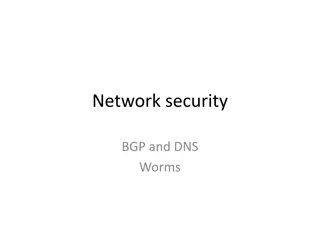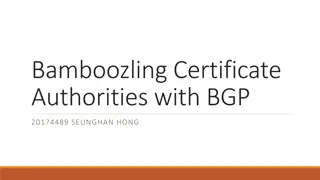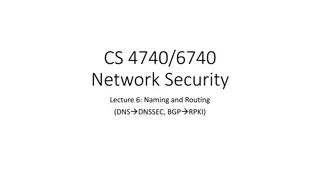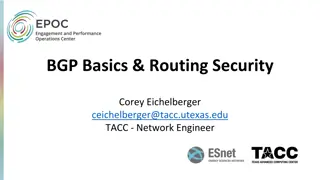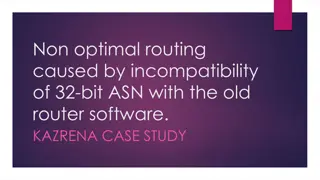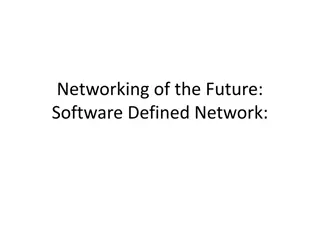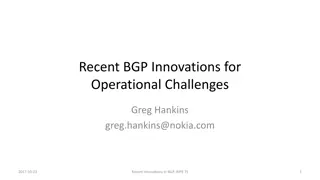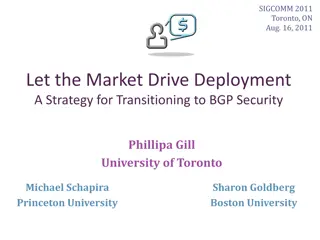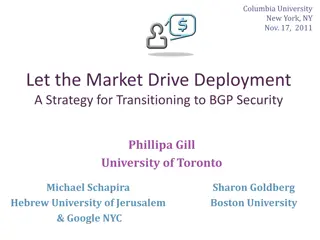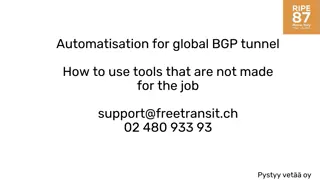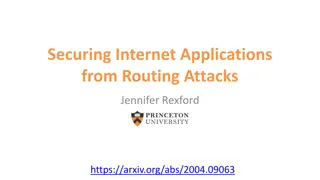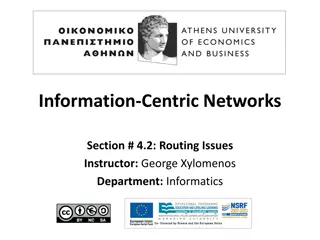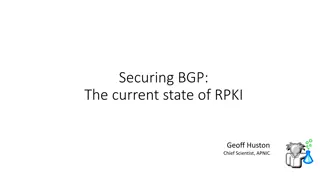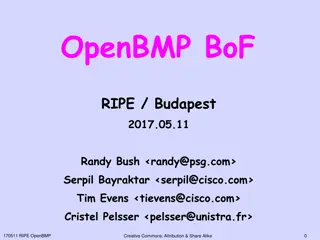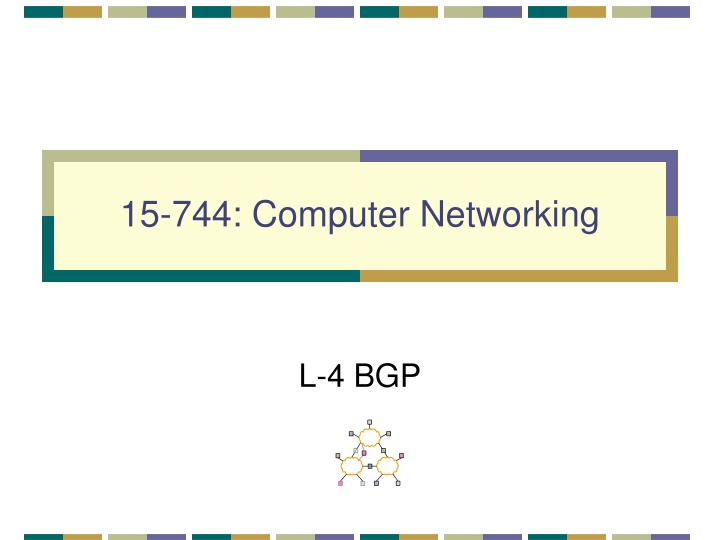
Interdomain Routing with BGP in Computer Networking
Explore the world of Border Gateway Protocol (BGP) in computer networking, covering topics like hierarchical routing, AS relationships, multi-homing, stability issues, and more. Dive into the need for less information with increasing distance to destinations, routing hierarchies, areas, path sub-optimality, and a logical view of the internet's structure. Enhance your knowledge of BGP ASes, policies, attributes, and path selection for efficient interdomain routing.
Download Presentation

Please find below an Image/Link to download the presentation.
The content on the website is provided AS IS for your information and personal use only. It may not be sold, licensed, or shared on other websites without obtaining consent from the author. If you encounter any issues during the download, it is possible that the publisher has removed the file from their server.
You are allowed to download the files provided on this website for personal or commercial use, subject to the condition that they are used lawfully. All files are the property of their respective owners.
The content on the website is provided AS IS for your information and personal use only. It may not be sold, licensed, or shared on other websites without obtaining consent from the author.
E N D
Presentation Transcript
15-744: Computer Networking L-4 BGP
Next Lecture: Interdomain Routing BGP Assigned Reading MIT BGP Class Notes [Gao00] On Inferring Autonomous System Relationships in the Internet 2
Outline Need for hierarchical routing BGP ASes, Policies BGP Attributes BGP Path Selection iBGP Inferring AS relationships Multi-Homing Stability Issues 3
Routing Hierarchies Flat routing doesn t scale Each node cannot be expected to have routes to every destination (or destination network) Key observation Need less information with increasing distance to destination Two radically different approaches for routing The area hierarchy The landmark hierarchy 4
Areas Divide network into areas Areas can have nested sub-areas Constraint: no path between two sub-areas of an area can exit that area Hierarchically address nodes in a network Sequentially number top- level areas Sub-areas of area are labeled relative to that area Nodes are numbered relative to the smallest containing area 1 2 2.2 2.1 1.1 2.2.2 2.2.1 1.2 1.2.1 1.2.2 3 3.2 3.1 5
Routing Within area Each node has routes to every other node Outside area Each node has routes for other top-level areas only Inter-area packets are routed to nearest appropriate border router Can result in sub-optimal paths 6
Path Sub-optimality 1 2 2.1 2.2 1.1 2.2.1 1.2 1.2.1 start end 3.2.1 3 3 hop red path vs. 2 hop green path 3.2 3.1 7
A Logical View of the Internet National (Tier 1 ISP) Default-free with global reachability info Eg: AT & T, UUNET, Sprint Tier 3 Tier 2 Regional (Tier 2 ISP) Regional or country-wide Eg: Pacific Bell Tier 2 Customer Provider Tier 1 Tier 1 Local (Tier 3 ISP) Eg: Telerama DSL Tier 2 8
Outline Need for hierarchical routing BGP ASes, Policies BGP Attributes BGP Path Selection iBGP Inferring AS relationships Multi-Homing Stability Issues 12
Autonomous Systems (ASes) Autonomous Routing Domain Glued together by a common administration, policies etc Autonomous system Term for BGP s ARDs Has an unique 16 bit ASN assigned to it and typically participates in inter-domain routing Examples: MIT: 3, CMU: 9 AT&T: 7018, 6341, 5074, UUNET: 701, 702, 284, 12199, Sprint: 1239, 1240, 6211, 6242, How do ASes interconnect to provide global connectivity How does routing information get exchanged 13
Nontransit vs. Transit ASes ISP 2 ISP 2 ISP 1 ISP 1 Nontransit AS might be a corporate or campus network. Could be a content provider IP traffic NET A NET A Traffic NEVER flows from ISP 1 through NET A to ISP 2 (At least not intentionally!) 14
Customers and Providers provider provider provider customer IP traffic customer customer Customer pays provider for access to the Internet 15
The Peering Relationship A C B Peers provide transit between their respective customers peer peer provider customer Peers do not provide transit between peers traffic allowed traffic NOT allowed Peers (often) do not exchange $$$ 16
Peering Wars Peer Don t Peer Reduces upstream transit costs Can increase end-to-end performance May be the only way to connect your customers to some part of the Internet ( Tier 1 ) You would rather have customers Peers are usually your competition Peering relationships may require periodic renegotiation Peering struggles are by far the most contentious issues in the ISP world! Peering agreements are often confidential. 17
Routing in the Internet Link state or distance vector? No universal metric policy decisions Problems with distance-vector: Bellman-Ford algorithm may not converge Problems with link state: Metric used by routers not the same loops LS database too large entire Internet May expose policies to other AS s 18
Solution: Distance Vector with Path Each routing update carries the entire path Loops are detected as follows: When AS gets route check if AS already in path If yes, reject route If no, add self and (possibly) advertise route further Advantage: Metrics are local - AS chooses path, protocol ensures no loops 19
BGP-4 BGP = Border Gateway Protocol Is a Policy-Based routing protocol Is the EGP of today s global Internet Relatively simple protocol, but configuration is complex and the entire world can see, and be impacted by, your mistakes. 1989 : BGP-1 [RFC 1105] 1990 : BGP-2 [RFC 1163] 1991 : BGP-3 [RFC 1267] 1995 : BGP-4 [RFC 1771] Support for Classless Interdomain Routing (CIDR) Replacement for EGP (1984, RFC 904) 20
BGP Operations (Simplified) Establish session on TCP port 179 AS1 BGP session Exchange all active routes AS2 While connection is ALIVE exchange route UPDATE messages Exchange incremental updates 21
Interconnecting BGP Peers BGP uses TCP to connect peers Advantages: Simplifies BGP No need for periodic refresh - routes are valid until withdrawn, or the connection is lost Incremental updates Disadvantages Congestion control on a routing protocol? Inherits TCP vulnerabilities! Poor interaction during high load 22
Policy with BGP BGP provides capability for enforcing various policies Policies are not part of BGP: they are provided to BGP as configuration information BGP enforces policies by choosing paths from multiple alternatives and controlling advertisement to other AS s Import policy What to do with routes learned from neighbors? Selecting best path Export policy What routes to announce to neighbors? Depends on relationship with neighbor 24
Import Routes provider route peer route customer route ISP route From From provider provider From From provider provider From From peer peer From From peer peer From From customer customer From From customer customer 27
Export Routes provider route peer route customer route ISP route To To From From provider provider provider provider To To peer peer To To peer peer To To To To customer customer customer customer filters filters block block 28
BGP UPDATE Message List of withdrawn routes Network layer reachability information List of reachable prefixes Path attributes Origin Path Metrics All prefixes advertised in message have same path attributes 29
Path Selection Criteria Information based on path attributes Attributes + external (policy) information Examples: Hop count Policy considerations Preference for AS Presence or absence of certain AS Path origin Link dynamics 30
Important BGP Attributes Local Preference AS-Path MED Next hop 31
LOCAL PREF Local (within an AS i.e. iBGP) mechanism to provide relative priority among BGP routers (choose highest Local Pref) R5 R1 R2 AS 200 AS 100 AS 300 R3 R4 Local Pref = 500 Local Pref =800 I-BGP AS 256 32
LOCAL PREF Common Uses Handle routes advertised to multi-homed transit customers Should use direct connection (multihoming typically has a primary/backup arrangement) Peering vs. transit Prefer to use peering connection, why? In general, customer > peer > provider Use LOCAL PREF to ensure this 33
AS_PATH List of traversed AS s Useful for loop checking and for path-based route selection (length, regexp) AS 200 170.10.0.0/16 AS 100 180.10.0.0/16 AS 300 180.10.0.0/16 300 200 100 170.10.0.0/16 300 200 AS 500 34
Multi-Exit Discriminator (MED) Hint to external neighbors about the preferred path into an AS Non-transitive attribute Different AS choose different scales Used when two AS s connect to each other in more than one place 35
MED Typically used when two ASes peer at multiple locations Hint to R1 to use R3 over R4 link (lowest MED) Cannot compare AS40 s values to AS30 s 180.10.0.0 MED = 50 R1 R2 AS 10 AS 40 180.10.0.0 MED = 120 180.10.0.0 MED = 200 R3 R4 AS 30 36
MED MED is typically used in provider/subscriber scenarios It can lead to unfairness if used between ISP because it may force one ISP to carry more traffic: ISP1 SF ISP2 NY ISP1 ignores MED from ISP2 ISP2 obeys MED from ISP1 ISP2 ends up carrying traffic most of the way 37
Route Selection Process Highest Highest Local Preference Preference Local Enforce relationships Shortest ASPATH Shortest ASPATH Lowest MED Lowest MED i i- -BGP < e BGP < e- -BGP Lowest IGP cost Lowest IGP cost to BGP egress to BGP egress Traffic engineering BGP Throw up hands and Lowest router ID Lowest router ID break ties 38
Policy Impact Different relationships Transit, Peering Export policies selective export Valley-free routing Number links as (+1, 0, -1) for customer-to- provider, peer and provider-to-customer In any path should only see sequence of +1, followed by at most one 0, followed by sequence of -1 43
How to infer AS relationships? Can we infer relationship from the AS graph From routing information From size of ASes /AS topology graph From multiple views and route announcements [Gao00] Three-pass heuristic Data from University of Oregon RouteViews [SARK01] Data from multiple vantage points 44
[Gao00] Basic Algorithm Phase 1: Identify the degrees of the ASes from the tables Phase 2: Annotate edges with transit relation AS u transits traffic for AS v if it provides its provider/peer routes to v. Phase 3: Identify P2C, C2P, Sibling edges P2C If and only if u transits for v, and v does not, Sibling otherwise 45
How does Phase 2 work? Notion of Valley free routing Each AS path can be Uphill Downhill Uphill Downhill Uphill P2P P2P -- Downhill Uphill P2P Downhill How to identify Uphill/Downhill Heuristic: Identify the highest degree AS to be the end of the uphill path (path starts from source) 46
Outline Need for hierarchical routing BGP ASes, Policies BGP Attributes BGP Path Selection iBGP Inferring AS relationships Multi-Homing Stability Issues 47
Multi-homing With multi-homing, a single network has more than one connection to the Internet. Improves reliability and performance: Can accommodate link failure Bandwidth is sum of links to Internet Challenges Getting policy right (MED, etc..) Addressing 48
Multi-homing to Multiple Providers Major issues: Addressing Aggregation Customer address space: Delegated by ISP1 Delegated by ISP2 Delegated by ISP1 and ISP2 Obtained independently ISP3 ISP1 ISP2 Customer 49
Address Space from one ISP Customer uses address space from ISP1 ISP1 advertises /16 aggregate Customer advertises /24 route to ISP2 ISP2 relays route to ISP1 and ISP3 ISP2-3 use /24 route ISP1 routes directly Problems with traffic load? ISP3 138.39/16 ISP1 ISP2 Customer 138.39.1/24 50
Pitfalls ISP1 aggregates to a /19 at border router to reduce internal tables. ISP1 still announces /16. ISP1 hears /24 from ISP2. ISP1 routes packets for customer to ISP2! Workaround: ISP1 must inject /24 into I-BGP. ISP3 138.39/16 ISP1 ISP2 138.39.0/19 Customer 138.39.1/24 51
Address Space from Both ISPs ISP1 and ISP2 continue to announce aggregates Load sharing depends on traffic to two prefixes Lack of reliability: if ISP1 link goes down, part of customer becomes inaccessible. Customer may announce prefixes to both ISPs, but still problems with longest match as in case 1. ISP3 ISP1 ISP2 204.70.1/24 138.39.1/24 Customer 52
Address Space Obtained Independently Offers the most control, but at the cost of aggregation. Still need to control paths ISP3 ISP1 ISP2 Customer 53
Outline Need for hierarchical routing BGP ASes, Policies BGP Attributes BGP Path Selection iBGP Inferring AS relationships Multi-Homing Stability Issues 54
Safety: No Persistent Oscillation 1 3 0 1 0 1 0 2 1 0 2 0 3 2 0 3 0 2 3 Varadhan, Govindan, & Estrin, Persistent Route Oscillations in Interdomain Routing , 1996 55
Main Idea of Optional Paper Permit only two business arrangements Customer-provider Peering Constrain both filtering and ranking based on these arrangements to guarantee safety Surprising result: these arrangements correspond to today s (common) behavior 56 Gao & Rexford, Stable Internet Routing without Global Coordination , IEEE/ACM ToN, 2001
Signs of Routing Instability Record of BGP messages at major exchanges Discovered orders of magnitude larger than expected updates Bulk were duplicate withdrawals Stateless implementation of BGP did not keep track of information passed to peers Impact of few implementations Strong frequency (30/60 sec) components Interaction with other local routing/links etc. 57
BGP Limitations: Oscillations (*R,1R,2R) AS 0 R AS 1 AS 2 (0R,1R,*R) (0R,*R,2R) 58
BGP Limitations: Oscillations AS 0 (-,*1R,2R) (*R,1R,2R) W R W W AS 1 AS 2 (*0R,-,2R) (0R,*R,2R) (0R,1R,*R) (*0R,1R,-) 59
BGP Limitations: Oscillations (-,*1R,2R) (-,*1R,2R) AS 0 01R 01R R AS 1 AS 2 (-,-,*2R) (*0R,-,2R) (*0R,1R,-) (01R,*1R,-) 60

